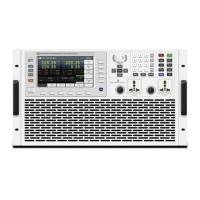Remote Control
Copyright© Itech Electronic Co., Ltd. 6
the instrument other computer:
1. Send the appropriate query command(s) in a program message.
2. Address the instrument to talk.
⚫ Rule 2: The complete response message must be received by the computer
before another program message can be sent to the instrument.
1.5 Command Format
Formats for command display are as follows:
[SOURce[1|2]:]VOLTage:UNIT {VPP|VRMS|DBM}
[SOURce[1|2]:]FREQuency:CENTer
{<frequency>|MINimum|MAXimum|DEFault}
Based on the command syntax, most commands (and certain Parameter) are
expressed in both upper and lower cases. Upper case refers to abbreviation of
commands. Shorter program line may send commands in abbreviated format.
Long-format commands may be sent to ensure better program readability.
For example, both formats of VOLT and VOLTAGE are acceptable in the above
syntax statements. Upper or lower case may be used. Therefore, formats of
VOLTAGE, volt and Volt are all acceptable. Other formats (such as VOL and
VOLTAG) are invalid and will cause errors.
⚫ Parameter options with given command strings are included in the brace
({ }). The brace is not sent along with command strings.
⚫ Vertical stripes (|) separate several parameter options with given
command strings. For example, {VPP|VRMS|DBM} indicates that you may
assign "APP", "VRMS" or "DBM" in the above commands. Vertical stripes
are not sent along with command strings.
⚫ Angle brackets (< >) in the second example indicates that a value must be
assigned to the parameter in the brace. For example, the parameter in the
angle bracket is <frequency> in the above syntax statements. Angle
brackets are not sent along with command strings. You must assign a
value (such as "FREQ:CENT 1000") to the parameter, unless you select
other options displayed in the syntax (such as "FREQ:CENT MIN").
⚫ Some syntax elements (such as nodes and Parameter) are included in
square brackets ([ ]). It indicates that these elements can be selected and
omitted. Angle brackets are not sent along with command strings. If no
value is assigned to the optional Parameter, the instrument will select a
default value. In the above examples, "SOURce[1|2]" indicates that you
may refer to source channel 1 by "SOURce" or "SOURce1" or "SOUR1" or
"SOUR". In addition, since the whole SOURce node is optional (in the
square bracket), you can refer to the channel 1 by omitting the whole
SOURce node. It is because the channel 1 is the default channel for
SOURce language node. On the other hand, if you want to refer to
channel 2, "SOURce2" or "SOUR2" must be used in the program line.
Colon (:)
It is used to separate key words of a command with the key words in next level.
As shown below:
APPL:SIN 455E3,1.15,0.0
In this example, APPLy command assigns a sine wave with frequency of 455
KHz, amplitude of 1.15 V and DC offset of 0.0 V.

